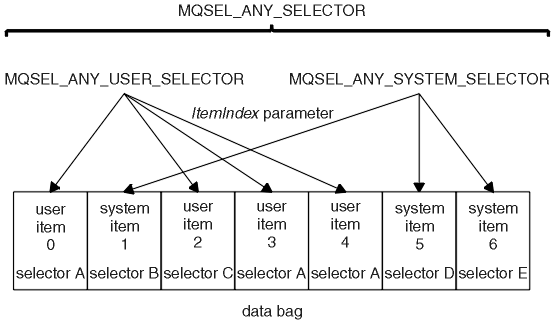Indexing in the MQAI
Indexes are used when replacing or removing existing data items from a bag. There are three types of indexing, which allows data items to be retrieved easily.
Each selector and value within a data item in a bag have three associated index numbers:- The index relative to other items that have the same selector.
- The index relative to the category of selector (user or system) to which the item belongs.
- The index relative to all the data items in the bag (user and system).
This allows indexing by user selectors, system selectors, or both as shown in Figure 1.
- selector A (ItemIndex 1)
- MQSEL_ANY_USER_SELECTOR (ItemIndex 2)
- MQSEL_ANY_SELECTOR (itemIndex 3)
The index is zero-based like an array in C; if there are 'n' occurrences, the index ranges from zero through 'n-1', with no gaps.
Indexes are used when replacing or removing existing data items from a bag. When used in this way, the insertion order is preserved, but indexes of other data items can be affected. For examples of this, see Change information within a bag and Delete data items.
The three types of indexing allow easy retrieval of data items. For example, if there are three instances of a particular selector in a bag, the mqCountItems call can count the number of instances of that selector, and the mqInquire* calls can specify both the selector and the index to inquire those values only. This is useful for attributes that can have a list of values such as some of the exits on channels.
Parent topic: Advanced MQAI topics